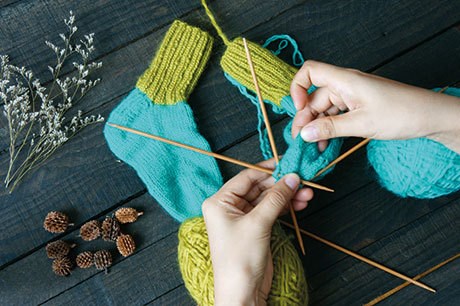EYFS Activities: Essential experiences… arts and crafts
Monday, October 16, 2017
From pottery to knitting, taking part in arts and crafts activities is easy thanks to the wealth of opportunities out there, writes Penny Tassoni

Years ago, most children would have seen a range of everyday arts and crafts taking place either in their home or in their local neighbourhood. Today many children only ever see finished products in shops and so miss learning about the processes involved. Arts and crafts encompass everything from knitting and sewing through to designing and making fabric, tiles and jewellery.
BENEFITS
For children, arts and crafts activities have many developmental benefits.
Physical skills Most arts and crafts activities involve some level of fine motor movement alongside hand-eye co-ordination. This might include a tripod grasp when using a needle or holding a paintbrush.
Language development Every arts and crafts activity will have specific vocabulary. This might include the words ‘teasing and carding’ if children are preparing wool for spinning, or ‘slip’ if children are watching a potter join two pieces of clay. Watching or, better still, joining in arts and crafts activities is likely to encourage children to chat and also ask questions.
Cognition There are many cognitive benefits to learning about how things are made. Children can make connections between objects that they have seen and how they are made. They can learn about sequencing, as there is an order in which things are created. They can also learn about different textures and shapes.
Emotional development While children may work alongside adults or need assistance for their own projects, they can learn the skills involved in being creative, including patience and persistence. These skills are important as they are about controlling emotion and impulses.
PLANNING A PROGRAMME
It is worth creating a programme of events so that children can see and, where possible, join in a range of arts and crafts. A good starting point is to find out from parents, friends and colleagues whether any of them have hobbies or contacts relating to arts and crafts.
The list of art and crafts is endless, but could include pottery, knitting, floristry, woodturning, beading and weaving. You could also visit www.craftanddesign.net/craft-guilds to find out what is going on in your area. It may also be worth looking at local adult courses to see if the tutor or any of the more experienced participants would consider supporting your setting. The retailer Hobbycraft also runs sessions for children that you may be able to access, if there is a store in your area.
Practical matters
Once you have made contact, the next step is to discuss with the person what they may be able to show the children and also how the children may be involved in some way. It will be worth talking about the optimum group size whether or not an outing is needed.
It is also worth talking about the type of follow-up activities that the children may be able to try out under adult supervision and the materials that you would need to buy or collect to support this.
As with any new activity or experience, it will also be important to carry out a risk assessment as many craft activities use specific tools or processes that may pose a hazard if not managed.
Building on craft experiences
There are many ways of building on craft activities that children have seen or been involved with. It is always helpful to document the process by using photographs, so that children afterwards can talk about what they have seen and done. There will be some craft activities that you may be able to recreate with the children – these may include floristry, simple sewing and pottery.
HOME LEARNING
While some parents may already be making things with their children, they may not realise how valuable an experience this is for their children’s learning. You might be able to share ideas with parents and even create some simple kits for them to try out at home. This might be something as simple as decorating boxes or doing a simple sewing project.
It is also worth signposting parents to events in the local community. Some libraries, museums and art galleries regularly hold workshops for children which are often free or subsidised. If you are lucky enough to have several contacts, you could also organise a family learning session, so that children and their parents could learn about new crafts alongside each other.
One thing which it is important to emphasise for parents, though, is that children’s skill level will at first be relatively low, and so expectations have to be realistic.
It is the process that matters and the enjoyment of this process that they should focus on.




